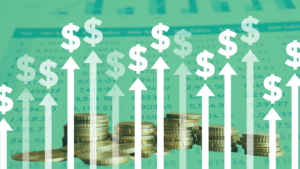The 1970s saw some of the highest rates of inflation in the United States in recent history, with interest rates rising in turn to nearly 20%. Central bank policy, the abandonment of the gold window, Keynesian economic policy, failed energy policies, and market psychology all contributed to this decade of high inflation.
When President Jimmy Carter took office in January 1977, unemployment had reached 7.4 percent. Carter responded with an ambitious spending program and called for the Federal Reserve (the Fed) to expand the money supply. Within two years, inflation had climbed to 13.3 percent.3 Responding to energy concerns that had persisted through much of the 1970s, his administration enacted a national energy policy designed to promote energy conservation and the development of alternative resources.
Hmmmm . . . sound familiar?
Folks, we have not seen this type of inflation in a generation. So, while we’ve talked about inflation here before, this week I want to use our time together to take a deeper look at just what is driving inflation. You might see inflation talked about in the context of stats and graphs, but today, I want to look at what inflation actually is.
Let’s start with the basic definition; inflation is essentially a general increase in prices and a fall in the purchasing value of money. In an environment of high inflation, money is worth less, so it costs more to buy the same number of things. But what the basic definition of inflation does not specify is what things are being bought – and this makes a big difference.
For context, two of the most quoted inflation figures—the headline number and the core number—differ in that the headline number includes energy and food, while the core number does not. For anyone who eats, who drives a car, or who heats their residence, the core number would seem to be beside the point. So, when we talk about inflation, we need to make sure what prices are included and then decide how relevant they are to our lives.
Then there are the standard measures of inflation. The Consumer Price Index₁, the best known of the inflation numbers, is based on the spending mix in a variety of areas, such as housing (42%), transportation (18%), and food and beverages (14%). These three categories make up almost three-quarters of inflation. The reason for this, of course, is that these three categories also make up most of the spending for most people. Between rent/mortgage, car payments and gas, and food, that tends to account for the bulk of most people’s budgets. And that is why the weights are what they are, to reflect how most people spend their money.
Now, of course this doesn’t account for everyone’s experience, and it’s not intended to. If you have a fixed-rate mortgage, your housing costs will stay more stable than the inflation numbers suggest. If you have an electric car, your transportation costs may be less when gas prices increase. And if you eat most of your meals at home, you won’t be as affected by restaurant price increases, but you cannot avoid getting whacked at the supermarket. It’s widely understood that this measure is imperfect. But, as standards go, it tries to reflect an “average” person’s spending along with a standard means of comparison. President Ronald Reagan said coming into office in 1981, “Inflation is as violent as a mugger, as frightening as an armed robber and as deadly as a hit man.” Milton Friedman chimed in a few years back and said, “Inflation is taxation without representation”. Unfortunately, this type of “tax” hits middle and lower middle-income Americans really hard.
When we talk about the high inflation we’re currently experiencing, we look at things, such as, housing, transportation and energy, and food. In all these cases, we see significant price increases. But if we look forward, we must consider whether those trends will continue.
For more context, let’s look at history, too. If we study the inflationary trends since the year 2000, we can see that housing for the most part has shown steady moderate increases, although it spiked a bit in 2009 and again in 2021. The food and beverages sector has shown more modest increases, but here again we saw faster gains from 2021 on. Finally, transportation was largely flat from 2008 through 2020, only to spike much more sharply in 2021.
Given the timing, it’s easy to see that our significant rise in inflation was due to a combination of increased money supply, change in energy policy, and the collision of more demand as economies reopened with the supply chain fractured from the pandemic. As the pandemic fades, we should also see inflation start to move back down as demand and supply chains normalize. But we will see . . . at least that’s what we’re all hoping for, right?
Unfortunately, it appears that it could be some time before we’ll see inflation return to our historical “normal”. So, what can you do? You probably won’t be surprised to hear me say, “Make a plan”. Make sure your plan has a downside risk mitigation system, and inflationary protection built in. While we can’t control inflation, we can prepare for it. Retirement planning is a long game, so take your best swing and keep your eye on the ball!
And as always – be vigilant and stay alert, because you deserve more!
Have a great week.
Jeff Cutter, CPA/PFS offers investment advisory services through Cutter Financial Group, LLC, an SEC Registered Investment Advisor with offices in Falmouth, Duxbury, and Mansfield.
Jeff can be reached at jeff@cutterfinancialgroup.com. Insurance products, including annuities, are offered through Cutterinsure, Inc., (MA insurance license #2080572). Cutter Financial Group and Cutterinsure are affiliated and under common control but offer services separately. Members of Cutter Financial Group’s management receive revenue directly from Cutterinsure. Any compensation received is separate from and does not offset regular advisory fees. Cutter Financial Group does not charge advisory fees on any insurance products. We do not offer tax or legal advice. Always consult with qualified tax/legal professionals regarding your own situation. Investing in securities involves risk, including possible loss of principal. Insurance product guarantees are backed by the financial strength and claims-paying ability of the issuing company. This article is intended to provide general information. It is not intended to offer or deliver investment advice in any way. Market data and other cited or linked-to content in this article is based on generally available information and is believed to be reliable. Please contact us to request a free copy of Cutter Financials’ Form CRS, Form ADV 2A and applicable Form ADV 2Bs. 1. https://tinyurl.com/35z5m55b 2. https://tinyurl.com/w7jdmpe7; 3. https://tinyurl.com/4adhu8t4








